МИНИСТЕРСТВО ОБЩЕГО И ПРОФЕССИОНАЛЬНОГО ОБРАЗОВАНИЯ СВЕРДЛОВСКОЙ ОБЛАСТИ
ГОСУДАРСТВЕННОЕ АВТОНОМНОЕ ПРОФЕССИОНАЛЬНОЕ ОБРАЗОВАТЕЛЬНОЕ УЧРЕЖДЕНИЕ СВЕРДЛОВСКОЙ ОБЛАСТИ
«СЕРГИНСКИЙ МНОГОПРОФИЛЬНЫЙ ТЕХНИКУМ»
Проект учебного занятия по иностранному языку (английскому языку)
ОУД.02
Тема занятия: «Устройство современного автомобиля»
Составитель: Терентюк Елена Анатольевна
Должность: преподаватель иностранного языка
Iквалификационная категория
Верхние Серги
2018 г.
Аннотация: В России появляется все больше иностранных автомобилей. Специалистам по профессии «Мастер по техническому обслуживанию и ремонту машинно-тракторного парка» будет не лишним изучить лексику по теме «Автомобили», «Устройство современного автомобиля» для того, чтобы обмениваться опытом c заграничными мастерами и применять полученные знания на практике. Достичь результата в освоении профессиональной лексики важно для преподавателя. Одним из резервов повышения мотивации учебной деятельности студентов может быть рациональное использование межпредметных связей. Проект учебного занятия по общеобразовательной учебной дисциплине английский язык предназначен для студентов 2 курса по специальности «Мастер по техническому обслуживанию и ремонту машинно-тракторного парка» и выполнена в соответствии с рабочей программой и стандартам ФГОС. Данный проект учебного занятия поможет студентам освоить основной модуль рабочей программы английского языка на уровне (elementary). А также обладать иноязычной коммуникативной компетенцией.
Цель:
I.Образовательная
1 - расширить словарный запас по теме «Устройство современного автомобиля».
2 - совершенствовать:
ранее сформированные знания по теме «Автомобиль» и «Средства передвижения»;
умения и навыки аудирование текста;
умения и навыки говорения при обсуждении вопросов, связанных с темой.
II. развивающая
развивать:
умение извлекать необходимую информацию при прослушивании текста;
мышление: учить опровергать, отвечать на вопросы.
III. воспитательная
развивать коммуникативную культуру, толерантность, интерес к профессии.
Создание образовательной среды, способствующей максимальному усвоению пройденного материала.
Тип занятия: Урок совершенствования знаний, умений и навыков
Вид занятия: Урок - практическое занятие.
Методы (приемы) обучения:
1. Коммуникативный
2. Репродуктивный
3. Частично-поисковый
Реализуемые межпредметные связи: Устройство и комплектация современного легкового автомобиля.
Учебно-методическое обеспечение занятия: Методическая разработка на тему: «Автомеханик», Сборник текстов.
Технические средства обучения: компьютер, комплект проекционного оборудования.
Наглядные пособия: презентация, дидактический материал.
Образовательные результаты:
| достижение студентами следующих результатов обучения (из программы дисциплины) | Преемственность с ОК (из ФГОС СПО) | Показатели освоения результата в рамках учебного занятия Студент: |
| Личностные готовность и способность к непрерывному образованию, включая самообразование, как в профессиональной области с использованием английского языка, так и в сфере английского языка;
| ОК 1. ОК 6. | Извлекать необходимую информацию. Осуществлять неподготовленное высказывание на заданную тему или в соответствии с ситуацией. |
| Метапредметные | ОК 3. | Обобщать информацию, полученную из текста, классифицировать ее, делать выводы. Формулировать грамматические правила, в том числе с использованием графической опоры (образца, схемы, таблицы).
|
| Предметные | ОК 4. ОК 5. | Правильно употреблять лексику в зависимости от коммуникативного намерения; обладать быстрой реакцией при выборе лексических единиц. |
ТЕХНОЛОГИЧЕСКАЯ КАРТА УЧЕБНОГО ЗАНЯТИЯ
| Этапы урока | Виды работы, формы, методы, приемы | Содержание педагогического взаимодействия |
| Деятельность преподавателя | Деятельность студентов |
| І. Организационный момент. Мотивация 20 минут | Репродуктивный метод | Приветствие, подведение студентов к теме урока. Постановка цели и задач перед аудиторией. | Записывают тему в тетради. |
| II. Основная часть урока 2.1Подготовка студентов к активному, сознательному усвоению. 20 минут | Активный метод Групповая форма работы | Изучение нового материала. Показ презентации (приложение № 1). Формирование коммуникативных навыков. Активизация в речи лексических единиц по теме. (приложение № 2) | Делают записи. Повторяют новые слова за преподавателем. Работа с карточками Читают текст. Отвечают на вопросы. |
| III. Активизация и совершенствование знаний по теме. 20 минут | Частично-поисковый метод форма работы групповая | Обобщение первичного закрепления и систематизации знаний. (приложение № 3) Организует выполнение упражнений Объясняет задания к упражнениям Контролирует правильность выполнения заданий Организует обсуждение результатов Организует процесс взаимопроверки и самопроверки | Делятся на группы и выполняют задания. Пишут тест по изученной лексике. Делятся на группы. Выполняют задания. Составляют предложения, с новой лексикой используя видовременную форму глагола.
|
| IV. Контроль и самоконтроль, коррекция 20 минут | Индивидуальная | Организует самостоятельную проверку с применением новых знаний, помогает учащимся выполнять контроль друг друга и самоконтроль. (приложение 4). | Выполняют самостоятельную работу, перекрестный контроль, самоконтроль. |
| V. Подведение итогов урока, рефлексия 10 минут | Фронтальная | Актуализирует внимание на пройденном материале, задает вопросы о задачах урока, побуждает к высказыванию своего мнения, соотносит достигнутые цели с поставленным результатом. (приложение 5) | Формулируют результат работы на уроке, называют основные тезисы усвоенного материала. |
Ход урока:
І. Организационный момент.
Преподаватель:Good morning, my dear students. I'm glad to see you all. Who is absent today? In the last lesson we taught the topic "production of cars in the Russian market." We know that the production of passenger cars in our country is growing. Today we will learn a new material "the Device of a modern car" and use new words with the help of exercises. The purpose and objective of our lesson – to expand the vocabulary on the topic and learn to extract the necessary information to develop interest in the profession. Let's start our lesson.
На прошлом уроке мы учили тему «Производство автомобилей на российском рынке». Мы знаем, что производство легкового автомобиля в нашей стране растёт. Сегодня мы изучим новый материал «Устройство современного автомобиля» и используем новые слова с помощью упражнений. Осваивая свою специальность и готовясь к будущей профессиональной деятельности, вы овладеваете специальной лексикой и терминологией, навыками и умениями читать специальную литературу, говорить и писать по темам и проблемам избранной вами профессии.
Цель и задача нашего урока – расширить словарный запас по теме, научиться извлекать необходимую информацию, развивать интерес к профессии.
II. Основная часть урока
2.1. Подготовка студентов к активному, сознательному усвоению.
Преподаватель:Look at the slide and repeat the parts of the car behind me. (Показывает презентацию и вместе правильно читают новые слова. Приложение № 1).

Студенты делают записи в тетради и готовятся отвечать на вопросы преподавателя.
Преподаватель: Мы посмотрели презентацию и выяснили, что многие части машины состоят из двух слов. Например: windscreen – лобовое стекло, или windscreen wiper – дворник. Если заглянуть в словарь и перевести слово wind, увидим много разных значений: ветер, дыхание, газы, если это слово выступает в роли существительного. А если wind – глагол, тогда значение меняет смысл и переводится в значении наматывать, обматывать. Тогда возникает вопрос, как же нам найти правильное значение лобового стекла? Ведь слово screen имеет тоже много разных значений. Ответ прост, нам надо знать и понимать, что мы имеем дело с профессиональной лексикой, которая используется в разных отраслях, профессиях и специальностях. Это терминология, которая находится в технических словарях. Наша с вами задача научиться правильно искать нужные значения и уметь пользоваться специальными словарями. Также, мы увидели много знакомых нам значений, похожих на русские части машины. Например: бампер – bumper, диск – disk, фильтр – filter. Делаем вывод, что устройство современного автомобиля на английском языке не совсем сложная лексика. Мы иногда даже не догадываемся, что многими словами пользуемся в русской речи, используя иноязычную лексику.
Преподаватель: Now we are using these words to answer the questions.
(Студентам раздаются карточки с рисунками частей автомобиля и заранее заготовленные вопросы)
Task 1. What are the numbered parts of the internal device of the car?
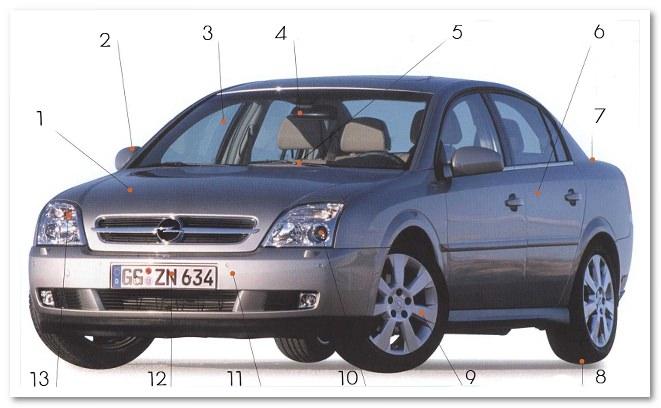
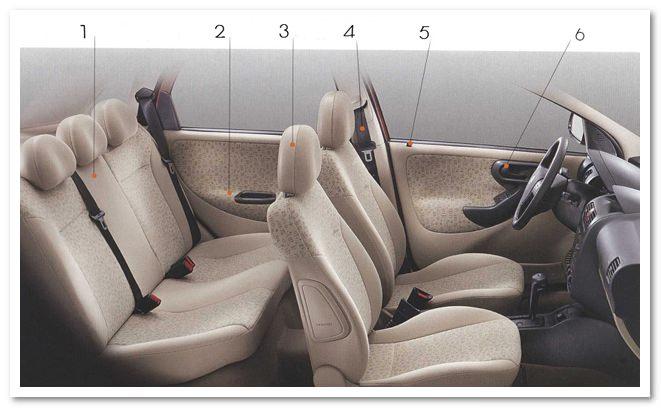
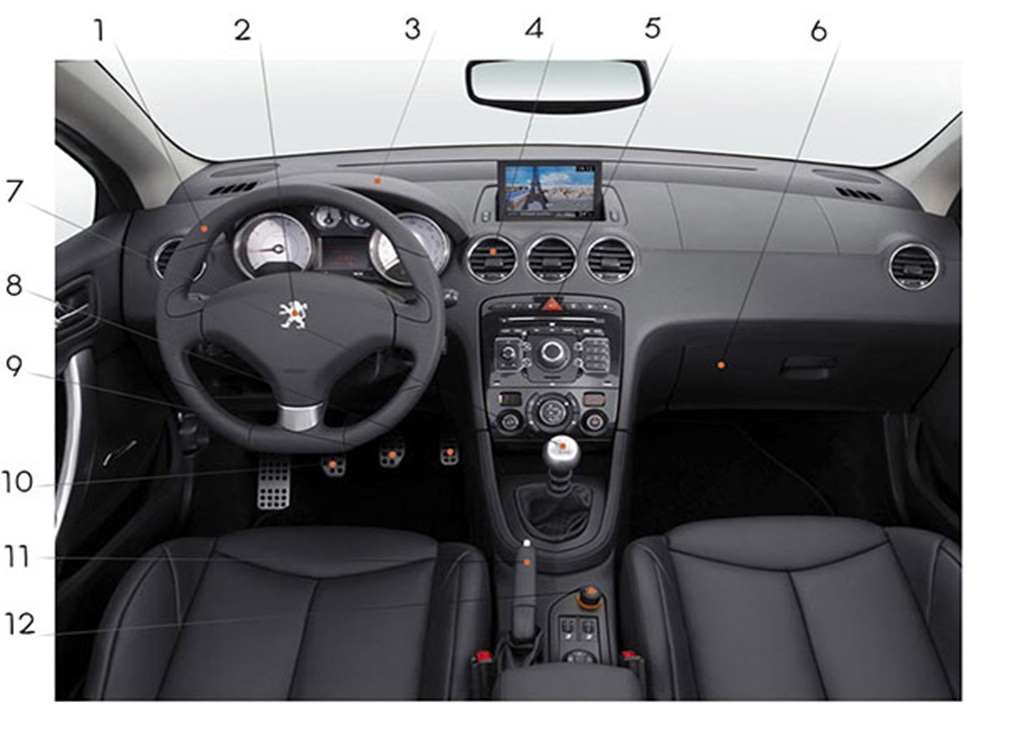
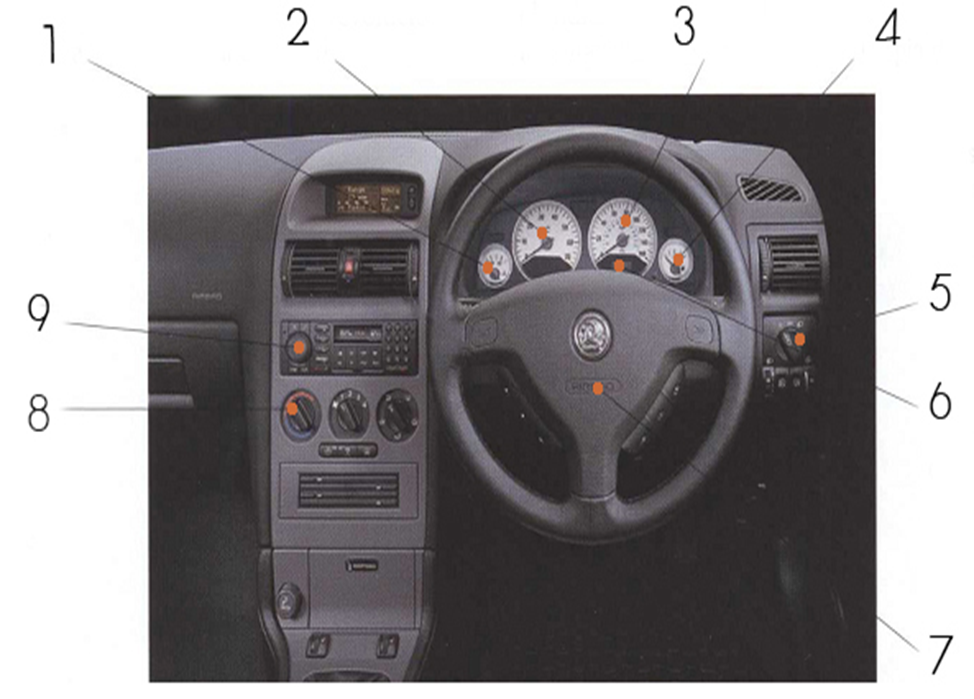
Студенты работают с карточками письменно. Вписывая слова в бланки ответов.
| № | World | | 1 |
| | 2 |
| | 3 |
| | 4 |
| | 5 |
| | 6 |
| | 7 |
| | 8 |
| | 9 |
| | 10 |
| | 11 |
| | 12 |
| | 13 |
| № | World |
| 1 |
|
| 2 |
|
| 3 |
|
| 4 |
|
| 5 |
|
| 6 |
|
| № | World | | 1 |
| | 2 |
| | 3 |
| | 4 |
| | 5 |
| | 6 |
| | 7 |
| | 8 |
| | 9 |
| | 10 |
| | 11 |
| | 12 |
| № | World |
| 1 |
|
| 2 |
|
| 3 |
|
| 4 |
|
| 5 |
|
| 6 |
|
| 7 |
|
Преподаватель: And now read the text and answer the questions on the text.Using the text to analyze what a part of the car is.
1 студент:
The automobile is made up of three basic parts: the power plant, or the engine, the chassis and the body.
The engine is the source of power that makes the wheels rotate and the car move. It includes fuel, cooling, lubricating and electric systems. Most automobile engines have six or eight cylinders.
2 студент:
The chassis includes a power train (power transmission), a running gear, steering and braking systems as well.
The power train carries the power from the engine to the car wheels.
3 студент:
The power transmission, in turn, contains the clutch, gearbox, propeller or cardan shaft, final drive, differential, rear axle and axle shafts. The running gear consists of a frame with axles, wheels and springs.
4 студент:
The body has a hood, fenders and accessories: the heater, stereo tape recorder, windshield wipers, conditioner, speedometer and so on.
5 студент:
What main parts is the automobile made up of?
6 студент:
What systems does the engine include?
7 студент:
What does the chassis consist of?
8 студент:
What has the body?
III. Активизация и совершенствование знаний по теме.
Преподаватель:Ok! Now, we divide into three groups. Each group is given a separate task and after training to check each other.
Студенты делятся на три группы по 7 человек.
Task 1 for the 1st group.
Topic “STEAM ENGINE.”
Vocabulary.
The 1st student read the worlds.
Steam chest – паросборник
These more...the more - чем больше….тем больше
Mostly - главным образом, большей частью
To invent – изобретать
To boil - кипеть
Pipe - труба
Steam - пар
Valves - клапана
Piston - поршень
To reach - достигать
Pressure - давление
Stroke - ход
Speed - скорость
Opening - отверстие
Read and translate the text.
STEAM ENGINE.
The 2nd student read and translates the text.
The steam engine was the first high-speed engine ever invented. The principle of the steam engine is simple. When water is boiled, it changes in to steam. The more the steam is heated, the more pressure it has.
The 3rd student read and translates the text.
A steam engine has some important parts. One is a boiler where fire turns water into steam. The steam goes through a pipe to the other important part - the steam chest with a cylinder and a piston in it. There are valves, or openings, in the steam chest. As the piston moves in the cylinder, it opens and closes the valves automatically, so that fresh steam enters just when the piston has reached the end of its stroke. A rod from the piston is connected to a wheel.
Now steam engines are mostly used in locomotives.
Answer the questions:
The 4th student answers the question.
1. What is connected to a wheel?
2. What are some important parts of a steam engine?
The 5th student answers the question.
3. What can you say about the principle of the steam engine?
The 6thstudent answers the question.
Are there are valves, or openings, in the steam chest?
How now steam engines are mostly used?
The 7th student answers the question.
Translate into English:
пар нагревается
поршень движется
важные части
огонь превращает воду
высокоскоростной двигатель
паросборник с цилиндром
окончание хода
соединяется с колесом
большее давление
Task 2 for the 2th group.
Topic “DIESEL ENGINE”
The 1st student read the worlds.
Vocabulary.
Gallon - галлон - англ. (4,54 л); амер. (3,78 л).
Besides – помимо, кроме
to last - длиться, продолжаться, сохраняться
screw – винт
like - похожий, подобный
directly - прямо, непосредственно
alone - один, только
immediately - немедленно, тотчас же
spray - брызги, струя, разбрызгивать, распылять
fuel – топливо
Spark plug – искра свечи
To connect - соединять
Charging – загрузка
To inject – впрыскивать
To ignite – зажигать
To use – использовать
Read and translate the text.
DIESEL ENGINE
The 2nd student read and translates the text.
A diesel engine is like a gasoline engine but simpler. Diesel engines are usually larger and can do more work. The fuel used in a diesel engine is oil. In diesel engines only air is blown into the cylinder. It does not need spark plugs. Diesel engines can be four - stroke ones and two - stroke ones.
The 3rd student read and translates the text.
Diesel engines use a cheaper kind of fuel and give more power for each gallon of fuel burned than gasoline engines. Besides they last much longer. In new trains and ships diesel engines run large generators which make electricity. The electricity runs motors which are connected to the wheels of the train or to the ship's screws.
The 4th student read and translates the text.
The diesel engine is an internal combustion engine. It uses oil as a fuel. The fuel is introduced in the form of spray and the engine requires no special ignition device.
In the four-stroke cycle Diesel engine air alone is drawn into the cylinder on the charging stroke. This air is being compressed on the return stroke to a very high pressure. The result of the combustion is that the air is heated to a high temperature.
The heavy oil injected into the air at the end of the stroke will be immediately ignited by It. The oil burns rapidly, but without explosion. The compression pressure is much higher than that in any other oil or gas engine.
Answer the questions:
The 5th student answers the question.
1. What happened at the end of the stroke?
2. Is in the four-stroke cycle Diesel engine air or petrol drawn into the cylinder on the charging stroke?
3. What is the result of the combustion?
The 6th student answers the question.
4. What is fuel used in a diesel engine?
5. A diesel engine is like a gasoline engine but simpler, isn’t it?
6. How diesel engines are used in new trains and ships?
True or false:
In new trains and plane diesel engines run large generators which make electricity.
The fuel used in a diesel engine is petrol.
The 7th student answers.
In the four-stroke cycle Diesel engine air alone is drawn into the cylinder on the charging stroke.
The oil burns slowly, but without explosion.
In new trains and ships diesel engines run large generators which make electricity.
Task 3for the 2th group.
Topic “STARTER MOTOR. HOW THE DRIVER STARTS THE CAR?”
Vocabulary.
The 1st student read the worlds.
STARTER MOTOR – Электрический стартер
To be put into engagement (зд.) – Сцепляться
Toothed ring – зубчатый венец
Periphery – обод
Disengagement gear – выключаемая шестерня
To project – выдаваться, выступать
Moisture – влага
To arrange – встраивать
Dust – грязь
Driver’ scabbing – кабина водителя
Action – действие
To release pressure on the clutch pedal –отпустить сцепление
To disengage - выключить
Direct drive – прямая передача
Speed – скорость
Handbrake – ручной тормоз
Lever - рычаг
Clutch pedal – педаль сцепления
Lightly – слегка
Accelerator pedal – педаль газа
To press – нажимать
To increase – увеличивать
Gearshift lever –рычаг переключения скоростей
The 2nd student read and translates the text.
Read and translate the text.
STARTER MOTOR
The starter motor is mounted on the left side of the engine. It is a small motor enclosed to prevent the dust and moisture from entering. The gear on the starter shaft is so arranged that. It can be put into engagement with a toothed ring cut on the periphery of the flywheel. The starter is only required to work for a few seconds. An automatic disengagement gear is used to put it out of action when the engine is started.
A steel rod connects it with the pedal that projects through the floor of the driver’s cabin. All that is necessary to start the car, is to press the starting pedal.
The 3rd student read and translates the text.
HOW THE DRIVER STARTS THE CAR?
Low speed. The driver releases the hand brake lever and presses on the clutch pedal in order to disengage the clutch. He moves the gear shift lever to the left and back. It is the low speed position. He releases pressure on the clutch pedal and at the same time presses lightly on the accelerator pedal. Now the car is started. He releases the second speed.
The 4thstudent read and translate the text.
Second speed. The driver released pressure on the accelerator and again disengages the clutch. He moves the gear shift lever through the neutral position. He returns the clutch pedal to its normal position and presses on the accelerator pedal. That is all. He engages the high speed.
High speed. The driver disengages the clutch as before. He pulls the gear shift lever back from the second position. He increases the speed of the engine. He looks at the speedometer.
The 5th student answers the question.
Answer the questions:
1. How starter motor is mounted?
2. What can you say about an automatic disengagement?
3. How the car is started?
The 6th student answers the question.
4. Does the driver move the gear shift lever through the neutral position?
5. The driver increases the speed of the engine at the high speed, doesn’t he?
6. What connects it with the pedal that projects through the floor of the driver’s cabin?
The 7th student answers.
True or false:
The gear on the starter shaft is so arranged that.
The starter motor is mounted on the right side of the engine.
It cannot be put into engagement with a toothed ring cut on the periphery of the flywheel.
He releases pressure on the clutch pedal and at the same time presses lightly on the brake pedal.
He moves the gear shift lever through the neutral position.
Студенты, работая в группах, проверяют друг друга в правильности использованной лексики и выполнении заданий.
IV. Контроль и самоконтроль, коррекция
Преподаватель: Thank you all for your work. Offer to work individually. I offer you purpose of self-control and correct use of professional vocabulary. Приложение № 4. Carefully read the job and check the correctness of reading new words. Thanks for the work.
Подведение итогов урока, рефлексия
Преподаватель: Today we worked on different tasks related to the new vocabulary. We were able to find out the terms related to your profession. Let us together define how the lesson was. What's complicated? Was it difficult or easy to work in class? Студентам раздаются листочки, чтобы они аргументировали свой ответ. Приложение №5.
Список литературы:
Александров, П.С. Английский язык для автотранспортных специальностей: Учебное пособие / П.С. Александров. - СПб.: Лань КПТ, 2016. - 128 c.
Бочарова, Е.П. Английский язык для студентов технических вузов: Уч. пособие / Е.П. Бочарова. - М.: Проспект, 2016. - 136 c.
Шляхова, В.А. Английский язык для автотранспортных специальностей: Учебное пособие / В.А. Шляхова. - СПб.: Лань, 2012. - 128 c.
Интернет-ресурсы:
http://www.englisch-hilfen.de/en/words/car.htm
http://www.vocabulary.cl/Advanced/Car_Parts.htm
http://www.edu.ru
6








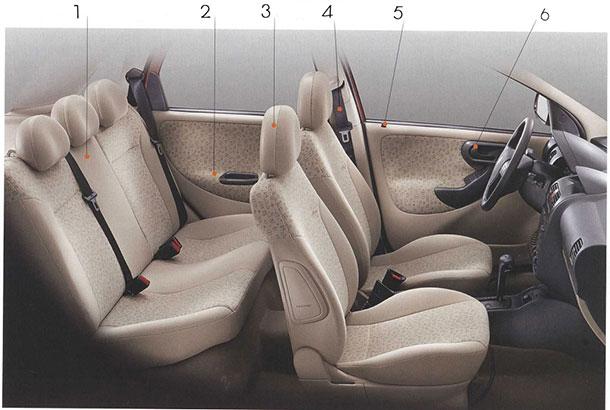
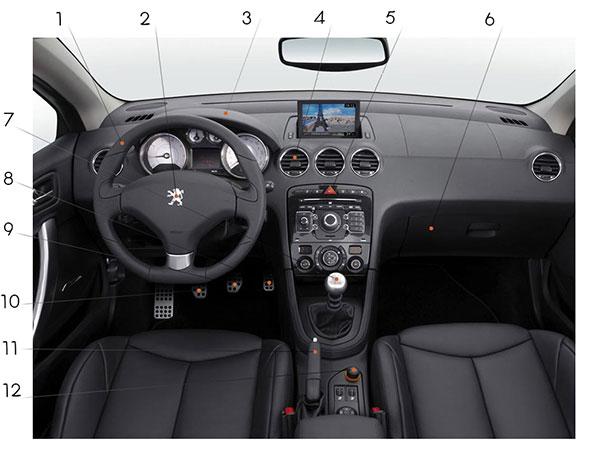
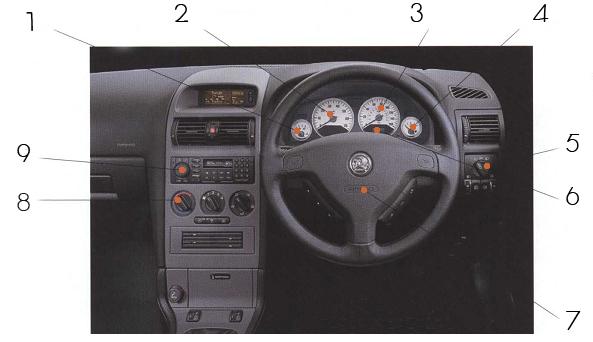





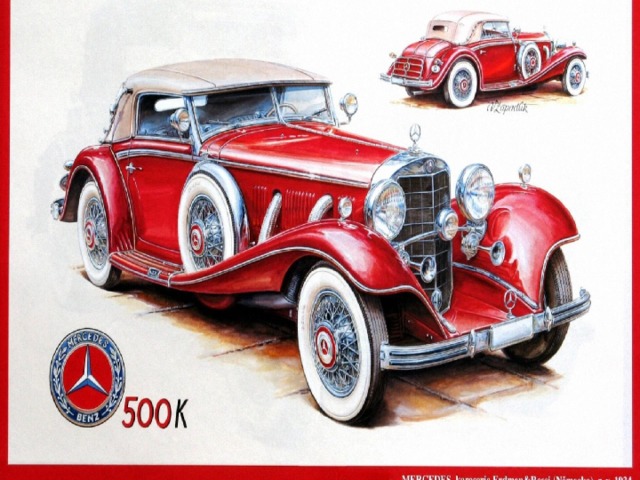
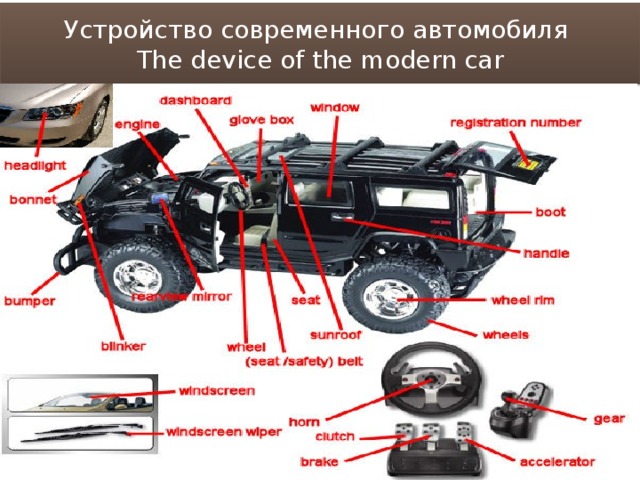

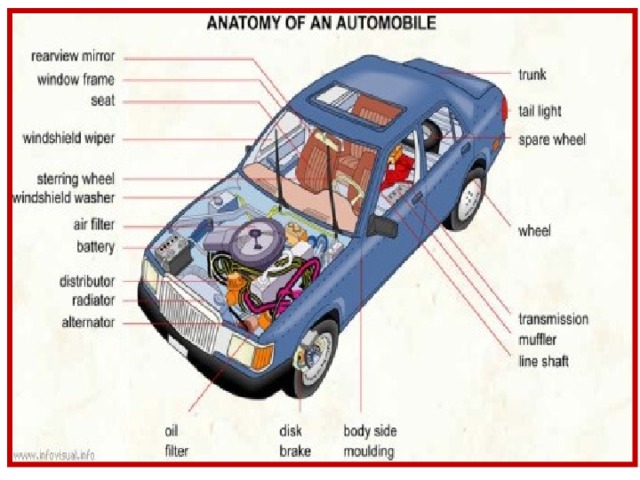


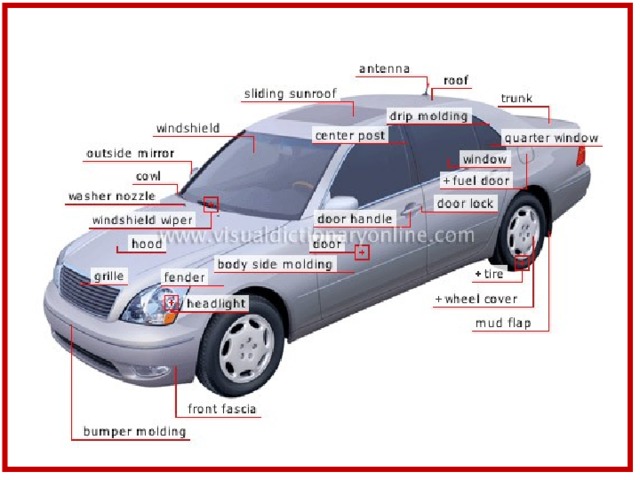


![Основные части автомобиля accelerator — педаль газа [ ək'seləreitə] battery — аккумулятор [ˈ batərē] bonnet / hood — капот [' bɔnit] boot / trunk — багажник brakes — тормоза [ brāk] bumper — бампер [ˈ bəmpər] clutch — сцепление [ kləCH] engine — двигатель [' enʤin] fan belt — ремень вентилятора first gear — первая скорость gear lever / gearshift — рычаг включения передач headlights — фары [ˈ hedˌlīt] motor — мотор [ˈ mōtər] reverse — задний ход [ ri'vɜ:s] shift — включать (передачу) [ SHift] silencer / muffler — выхлопная труба tail light — задний свет tire — шина [ tīr] transmission — коробка передач [ trænz'miʃn] wheel — колесо [' wi:l] wiper — стеклоочиститель [ˈ wīpər]](https://fsd.multiurok.ru/html/2018/05/17/s_5afd59b4261a8/img_s903338_0_9.jpg)
![Инструменты для ремонта автомобиля flashlight — карманный фонарик fuse — предохранитель jack — домкрат [ jak] oil — масло [ oil] pliers — клещи [ˈ plīərz] screwdriver — отвертка [ˈ skro͞oˌdrīvər] spare part — запчасти spark plug / sparking plug — свеча зажигания tool — инструмент [ to͞ol] wrench — гаечный ключ [ renCH]](https://fsd.multiurok.ru/html/2018/05/17/s_5afd59b4261a8/img_s903338_0_10.jpg)
![Виды транспортных средств armored car — бронеавтомобиль automobile — амер. автомобиль [' ɔtəməbi:l] bicycle / bike — разг. велосипед breakdown van / tow truck — эвакуатор car — автомобиль, машина caravan / RV (recreational vehicle) / motor home — жилой фургон, автомобиль-дача, трейлер company car — служебный автомобиль convertible — кабриолет [ kən'vɜ:təbl] estate car / station wagon — автомобиль с кузовом универсал four wheel drive / 4WD / 4x4 — автомобиль повышенной проходимости limousine / limo — разг. лимузин lorry / truck — грузовик motorcycle — мотоцикл patrol car — патрульный автомобиль pickup / pickup truck — пикап racing car — гоночный автомобиль sports car — спортивный автомобиль vehicle — транспортное средство [' vi:ikl]](https://fsd.multiurok.ru/html/2018/05/17/s_5afd59b4261a8/img_s903338_0_11.jpg)

















